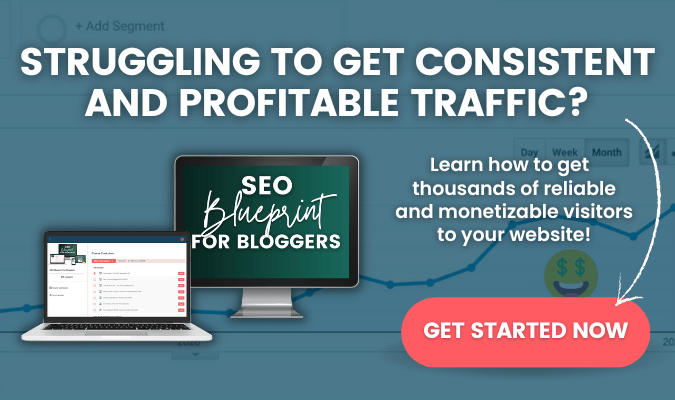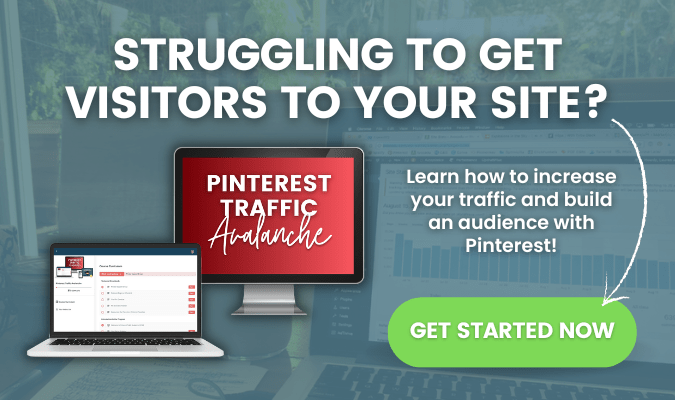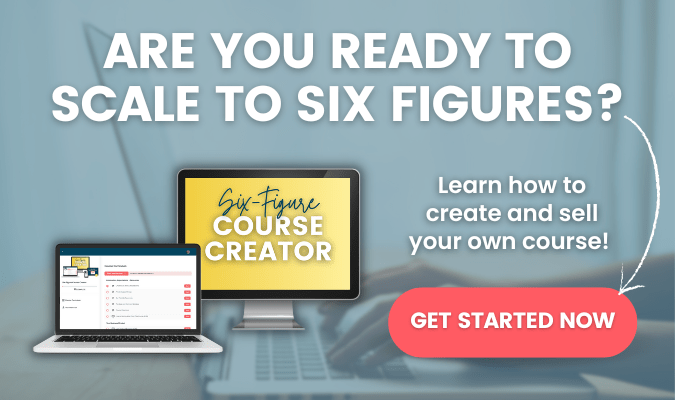We partner with bada$$ companies that offer products that help our readers achieve their goals! If you purchase through our partner links, we get paid for the referral at no additional cost to you! Read our disclosure for more info.
If you’re looking for a cutesy article that’s going to give you a high-level and vague overview of some blogging tips for beginners, this isn’t it. This is going to be a deep dive that both beginners and blogging pros can gain some massive insights from.
Growing and monetizing can be…
- Difficult
- Confusing
- Overwhelming
- And just plain hard sometimes.
But the thing is…
The steps to do this aren’t necessarily that hard to understand. They’re fairly straightforward. It’s more about taking the right steps in the right order to find quick success.
Here is a brief timeline of the success journey for our first health and wellness blog:
- It took 6 months to make ANY income at all.
- But from that point, the revenues doubled for the next few months.
- We reached our first sought-after goal of earning $10,000/month.
- The blog made a total of $103,457 by the end of that first year.
From there, this website was started and we have reached heights up to $200,000/month. You can read more about our income earnings in our blog income report.
Needless to say, there was a LOT of trial and error and lessons learned along that success journey. The blogging tips in this article are some of the most important lessons learned.
Each of these blog tips CAN make a serious impact on your bottom line, so we’re also going to give you actionable steps for each one so you can implement them in your own business.
1. Get Organized or Go Broke
Whether you just started yesterday or you are 10 years into this sh*t… organization is growth fuel.
Running a blog can be a tough job because it’s generally a one-man show and you have to be good at pretty much everything.
As a blogger, your job includes…
- Writing content
- Email marketing
- Product marketing
- Product sales
- Customer service
- Managing finances
- Graphic design
- Web design
- Social media marketing
- And more…
Large companies have whole departments for these jobs because each one of these tasks generally requires a special set of skills.
If you are really in touch with your creative side and great at writing, you’re probably not as naturally good with numbers and managing finances.
But you have to learn to be. As your blog grows, you will grow with it and learn to develop all of these skills over time.
Sure, some of this can be hired out at some point. But most people can’t afford to do that until they’ve started actually making money.
So, how do we do this?
You stay organized.
Prioritize and Focus on the #1 Most Important Thing
This is one of the best blogging tips for newer bloggers simply because you have a lot more work ahead of you when you’re just getting started.
It’s really easy to feel overwhelmed when you feel like you have a million things on your to-do list and never enough hours in the day.

You scratch one thing off your list and add 5 more.
If you’re anything like me, you sometimes go for the low-hanging fruit and “easy” tasks just to feel the satisfaction of crossing a few things off the list.
Forget your growing to-do list. Tear it up into little pieces. Light it on fire. Toss it out.
Your new to-do list is going to have ONE thing on it.
What is the #1 most important thing you can do TODAY that will have the greatest impact on your blog?
- Is it writing those first 10 posts that will establish your blog’s foundation?
- Maybe designing your home page?
- Or taking that SEO course because you REALLY need to get some traffic??
Whether it’s related to traffic, monetization, email marketing, writing content, or something else entirely, figure out what the ONE most important thing is to your bottom line right now.
Add that thing to your to-do list and FORGET everything else. Those other things can wait.
Whether it takes you one day or one week to get the most important thing accomplished.
This helps to ensure that you give your all to the task at hand and you make big moves quickly — rather than taking a few bites of everything here and there.
This is especially important for bigger tasks like creating products or implementing new strategies for growing your traffic.
Staying focused will help you stick to your deadlines and get tasks accomplished faster.
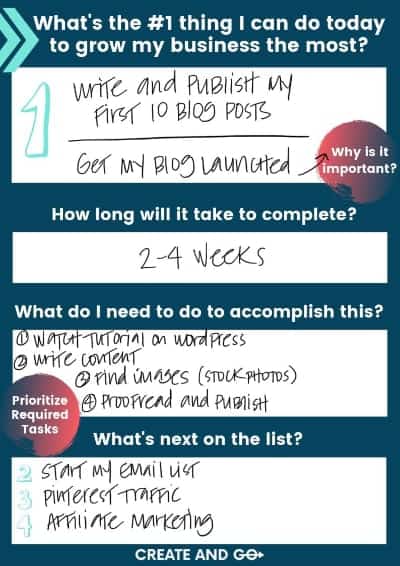
Download this One Thing To-Do List and use it as a guide to work on your one thing – every day.
Track Your Blog Revenues Properly
You’re probably not an accountant, but I used to be. Here is one of my best blogging tips for business:
Keep track of your business finances from the very beginning.
Being on top of your business finances can save you a LOT of money [that you can and should be re-investing back into your blog].
This will be much easier for some than others. With a background in accounting, I’m a numbers gal, for sure. But it’s okay if you’re not.
As long as you stay organized, you can easily stay on top of it.
Make sure that you’re keeping track of every expense that you can deduct against your income.
Your blog hosting, email marketing software, courses that you purchase, and even that Starbucks coffee you bought while you were writing that article…
Those are generally all tax-deductible, but only if you keep track of them.
Not only is it important from a money-saving and tax standpoint, but it’s also important to see where you are spending your money and how much money you are spending on a monthly basis.
Here’s what you need to do. Download this simple Blog Finances spreadsheet to track your expenses.
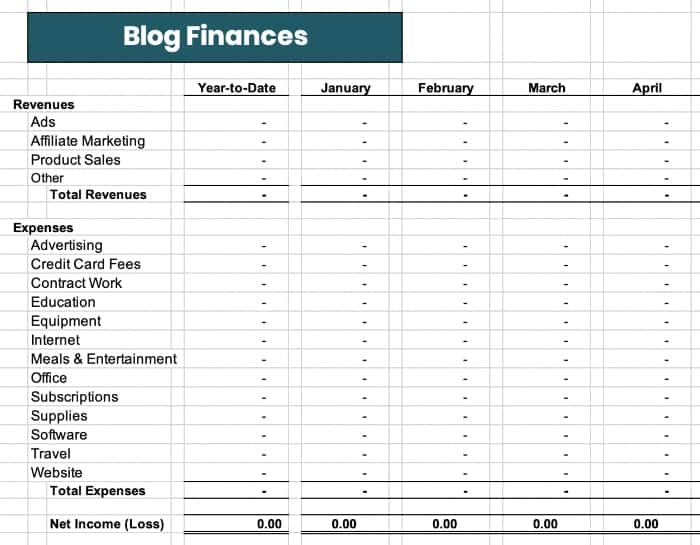
Each month, review your bank statements and input all business-related expenses (and revenues) into the spreadsheet.
There are formulas in the spreadsheet that will automatically carry these numbers over to your yearly overview, so you can compare your finances on a month-to-month basis.
At the end of the year, these totals are all you need to complete your tax return for your new business! You won’t have to dig through a year’s worth of statements and try to remember what the heck that charge was from 7 months ago.
Pro Tip: Consider using a separate credit card for business expenses so that you don’t have to dig through personal expenses each month.
2. Invest in Your Blog (3 Big Ones to Consider)
This is probably the #1 most important thing that we did to grow our first health blog and then this blog.
We tried absolutely everything and it cost us quite a bit to do it. We bought software, courses, you name it… anything that could maybe hopefully help us grow.
Most of them didn’t work. Wasted money, it would seem. But it’s not about that.
It’s about the ONE THING that did work.
If you’re lucky enough to find that one thing on the first try, props to you. I should take you to Vegas.
For most of us, it’s a massive trial and error process and you HAVE to invest some money along the way because the free information on the internet is generally fragmented and limited at best.
That’s because content creators and business owners save their best information for their paying customers. It’s how they earn a living.
You should be no different when you start monetizing your blog.
If you try to cruise by on free information and software, you’re going to get cheap results.
Sometimes it’s hard when you’re on a budget. I get that. So do choose your investments wisely.
But you still must invest because you are trying to start and grow an actual business, after all. Here are the three most important investments you should make for your blog.
1. Invest in Software (Design and Efficiency)
The very first investment you should make for your blog is for the right software.
Our absolute FAVORITE software tools for growing our business are:
- Bluehost — best web hosting for beginner bloggers
- Divi — most user-friendly and customizable blog theme for beginner bloggers
- ConvertKit — best email marketing software (we’ve used it for over 2 years now)
- Teachable — what we use to build and sell our online courses
Make sure you are constantly evaluating where your blog is at and that you aren’t waiting too long to invest in something your blog really needs to grow.
For example, once you begin driving traffic to your blog, you might need to invest in some landing page software like LeadPages or email collection software like Sumo.
Paid software usually has more options and more customization, which can result in more conversions and more sales, and a higher return on your investment.
If you’re getting some steady traffic to your blog and you don’t have the best software to collect emails, your email list will grow much slower and you will earn a lot less money when you begin to monetize.
2. Invest in Courses (New Strategies)
I’ve bought courses on webinars, product launches, Google, SEO, Pinterest traffic, and so much more.
While it was painful to spend the money before I had the revenue to cover it, I knew that in order to be successful, I needed to learn from people who were already successful.
The first thing that you need to do is identify what path you are on or want to be on and then choose the right course for your business based on that.
I remember taking courses on launching products and creating webinars when I barely had enough traffic to build an email list.
It’s not just about taking the right courses, but you also need to take them at the right time.
This is how and why we built our blogging courses. They are based on everything that we wish we had started with in the beginning. Hopefully, you can learn from some of our mistakes.
But even if you don’t want to try ours, find someone else’s courses that resonate with you. Or someone specifically that you want to learn from.
The point is…
If you keep searching through the masses of free information, you’re going to spend far more time searching and far less time taking real action (and making money).
3. Invest Your Time
It’s imperative that you spend as much TIME as possible on your blog if you really want to make a successful business out of it.
You have to make some serious sacrifices in those early days to get our blog off the ground.
And the worst part is…
While your close friends and family will probably support you no matter what, they almost certainly won’t actually understand. They’ll think you’re crazy when you turn them down for brunch yet another weekend in a row to work on your “blog.”
You’re on a VERY different journey than most of the world, and it can be very isolating and lonely at times because of that, but know that you ARE on the right path.
When you do reach higher levels of success, your friends and family will finally get it. They’ll understand why you gave up your nights and weekends for MONTHS to make this thing work.
If you don’t quit, you can’t fail.
It sounds dumb and cheesy but it’s totally true. Spend every spare moment you have on your blog. It will be worth it.
And when you start to notice things are falling off your plate, don’t be afraid to get help. Use a platform like Fiverr to find a virtual assistant or SEO specialist — so you can free your time for the most important parts of your blog.
3. Understand the Full Picture (A-Z)
This is an extension of one of the blogging tips above when we discussed being a one-man show and needing to both know and also be good at everything from sales to marketing to customer service.
There is no ONE THING that you need to be good at to be a successful blogger. There isn’t one key to success or one thing that will make or break you.
Blogging is an A to Z thing. First, you must work on letter A, then letter B, then letter C so on.
If you start with F to try to take a shortcut or because you just don’t know any better… you’re going to Capital F – F*ck it all up.
As I mentioned before, you have to take the right steps in the right order. Here is an oversimplified illustration of the process:

It’s only those that can connect A-Z that end up with six-figure success.
There are tons of bloggers who have a great product, but they can’t get anyone to buy it. There are other bloggers who have great content, but they can’t get any visitors to their site to read it.
It’s about having all the right pieces to the puzzle and putting them together correctly.
Letter A is the purpose of your blog, and Letter Z is the moment that people love your product so much that they’re sharing it with their friends and family.
Why Our First Blog Failed [Spectacularly]
I told you these blogging tips were coming straight from our lessons learned, and this one was a big one.
We mentioned our success story at the very beginning of this article, but what I haven’t mentioned yet is that we actually had another health and wellness blog BEFORE that one.
We tried to get that first one off the ground for a few months before ultimately scrapping it and starting over with the second health and wellness blog.
The first one failed for a variety of reasons, but most of it boiled down to the fact that we made all the right moves in all the wrong places.
We created a product before we knew anything about our blog readers or what they were even interested in. We also drank too many mimosas while trying to get our new business off the ground, but surely that wasn’t related.
We created a product based on who we thought our target customer was and what we thought they wanted, which meant that our marketing messages were all kinds of wrong.
And we sat around waiting for sales that never came.
It was frustrating and disappointing and just an all-around really tough time after we had poured our hearts into this first product.
And do you know what the craziest part was?
Our product wasn’t the problem.
It was a GREAT product and we recycled most of the content and repackaged it into our next weight loss program, which was a success from day 1!
It was just that we tried to run before we could walk. We tried to jump right into monetization before we spent the time on the steps that come before that – getting email subscribers, collecting feedback, adjusting your content strategy, etc.
You can’t take shortcuts too hastily because you will miss out on SO many learning opportunities along the way and only set yourself back further.
4. Prioritize Growing Your Email List
After that first blog failure, the most important thing we did to get turned back around in the right direction was to learn more about our readers.
In order to know who your target customer is and what problem you can help them solve, you need to know them.
And what better way to learn who they are and what they’re looking for than to simply ASK them.
When we scrapped the first blog, we started over completely — still in the health and wellness niche but we started a new blog with a completely new look and purpose.
This time around, we focused on collecting emails and getting subscribers before we did ANYTHING at all relating to trying to monetize.
We created tons of lead magnets to get people to sign up for our email list. Most of them ended up failing or not converting enough, but some of them began to bring in subscribers in droves…
Seriously, take a walk down our memory lane to see some of the opt-ins that we created that were ultimately scrapped:

Our weight loss content became very popular on Pinterest and we soon began building an email list of people interested in losing weight.
In our very first welcome email to our new subscribers, we asked them if they could tell us what the #1 thing they were struggling with when it came to losing weight.
And guess what we learned from that?
Everything we needed to know.
We didn’t just learn what they were struggling with. We received full stories of who they were, how old they were, how many diets they had tried that year, why their diets were failing them, and so much more.
This information was GOLD, and it gave us everything we needed to know exactly who our target customer was and how to design our content around this target customer.
Do NOT underestimate the importance of building an email list of raving fans right away.
How to Build an Email List of Raving Fans
Most of the people that visit your blog will never come back again.
People click around. They read and scan a bit. Maybe they love the content or maybe they don’t.
But chances are, they probably won’t remember you enough to return back to your blog. Unless you truly blew them away with your content, which is the goal…
But you need a way to capitalize on every visitor you get on your website.
You do this by converting someone from a reader into a subscriber and then into a raving fan that absorbs every piece of content you put out.
Let’s talk about how to do that.
1. Create an opt-in to get people to subscribe.
In the earlier internet days, all you needed to get people to sign up to your email list was to offer a free newsletter. Unfortunately, the days of free newsletters are long gone.
Here’s an example of an old newsletter signup page that we had on our health and wellness blog:
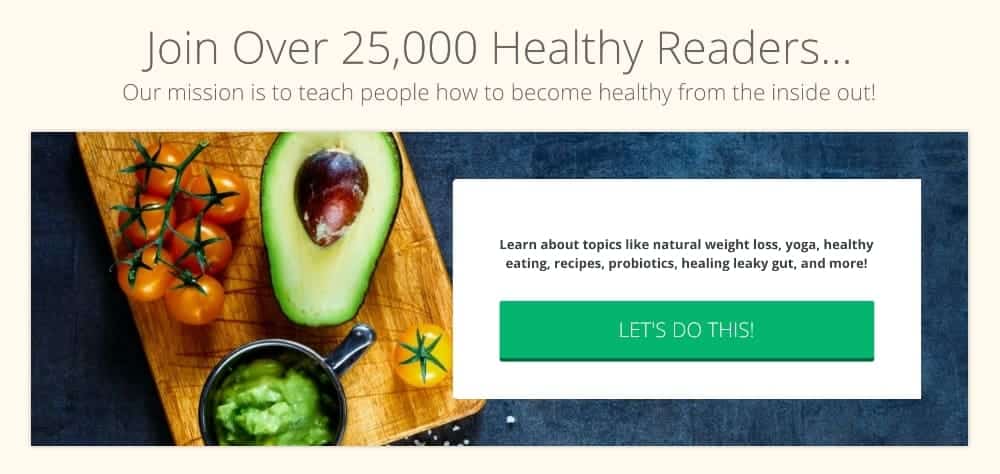
This page received very few email signups because it’s too generic and doesn’t offer the reader much in return for signing up, except for a vague promise for some additional healthy information.
People are aware that everyone is trying to sell something to them and they’re very reluctant to give up their email address without the promise of something in return.
You need to entice someone to sign up for your email list, and by far the best way to do this is by offering some kind of freebie (or lead magnet) in exchange for their email address.
The more free value you provide upfront to your reader, the more they will trust you and want to build a relationship with you.
You can present this freebie to subscribers using forms and landing pages called opt-ins.
Here is an example of a form we built using ConvertKit, our recommended email marketing service, for our Free 5-Day Blog Challenge:
As you can see, we offer free training guide in exchange for a reader’s email address.
Some common examples of free information, downloads, and resources that you can offer include:
- Checklists
- Planners
- Guides
- Courses
- eBooks
- Spreadsheets
These freebies should be related to your main blog topic and should serve to solve some kind of problem your reader is facing.
Another way to collect subscribers is through landing pages like this one for our Free 5-Day Start a Blog Challenge.
You can link these directly on your blog or from YouTube, Pinterest, or other traffic channels.
Take Action:
- Sign up for an email marketing service so that you can create forms like ours above to start collecting subscribers. We use and recommend ConvertKit.
- Create a freebie to offer. Canva is a great place to create this.
- Create your first form and landing page.
Once the subscriber opts into your email list, you need to send them their freebie + some additional content to start building that relationship with them.
2. Create a great welcome sequence.
A welcome sequence, also referred to as an email (or sales) funnel, is a series of emails that are automatically sent to a subscriber once they sign up for your email list.
You can set these emails to send out at specific times and specific days of your choosing.
It’s important to begin sending emails to your subscribers right after they opt in because this is when they are the most familiar with you and your content.
Subscribers turn “cold” when they haven’t heard from you in a while and they become less engaged with your content.
A good welcome sequence should include:
- An email that says thank you for signing up for the free download and gets them excited for it. (Remember to ASK why they are here!)
- A couple of follow-up emails providing additional value through free content. This can be by directing them to other posts or writing brand new content right in your emails.
We personally prefer ConvertKit to the other email marketing services we’ve tried because of the simplicity and the ability to create and edit all emails in one screen:
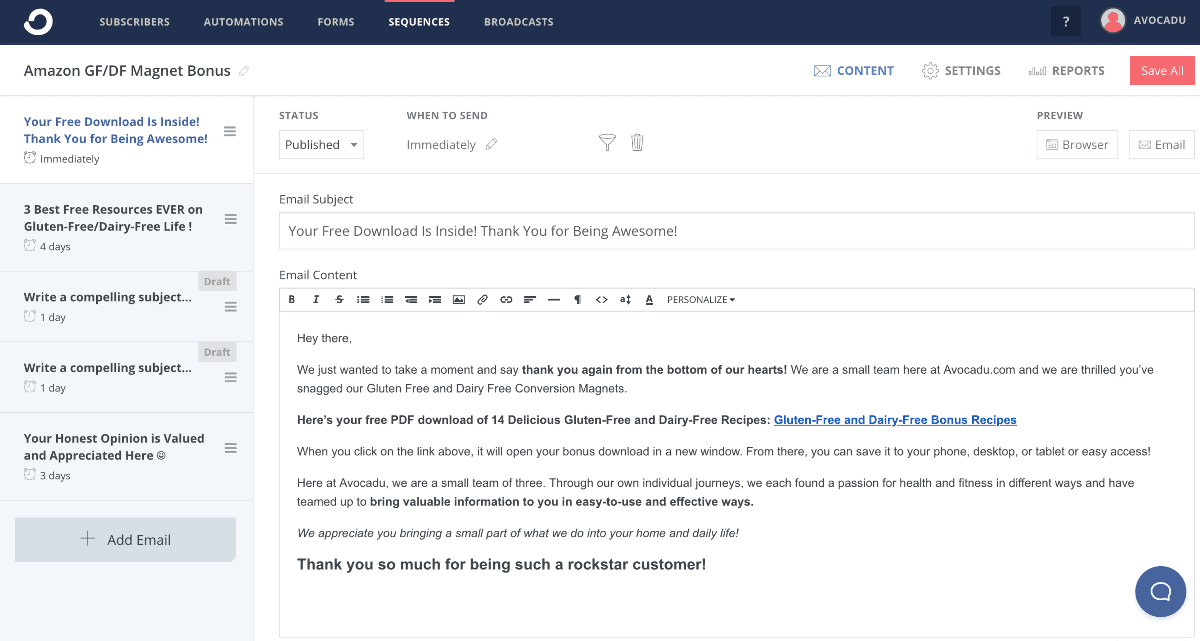
Once you create your sequence, you simply connect it to your forms and landing pages and your new subscribers will automatically start receiving your emails after they sign up!
5. Facts Tell and Stories Sell
As simple as this sounds, it’s actually one of our more advanced blogging tips that we discuss a lot more in our courses, especially Six-Figure Course Creator.
People don’t just want to read your basic How-To article. They want to read about your experience with the topic.
They don’t just want to know what the steps are. They want to hear WHY the steps worked or didn’t work out for you personally.
People make most purchasing decisions based on their emotions and how your product makes them feel – not based on your statistics that tell them that it works.
This is why we write and teach from personal experiences at Create and Go. It’s authentic and it’s relatable.
You can tell someone all day long that your product has helped over 1,000 people lose approximately 50 pounds in 5 months and back it up with all kinds of photos.
That matters. But it’s so much more powerful with a real story behind it. Testimonials.
And it’s just as important to discuss your failures as it is your successes, as you’ve seen in this blogging tips article so far.
People read this content because they want to make money but they choose Create and Go because they relate to our journey and how we talk.
We often use phrases like this on our sales pages:

If your reader can relate to what you are saying, they feel like they’re in the right place (and your product is right for them).
We often talk about working full-time jobs, feeling like we weren’t making enough money or getting enough vacation time, and we talk about the hard times before we started making any money.
Because that is where the majority of our audience is right NOW and how they are feeling NOW.
When writing blog posts or any content, put yourself in your reader’s shoes and tell your story as much as you can in ALL of your content.
6. Become the Expert
One major roadblock we see many people get hung up on before they start a blog is that believe they have to be an expert in something to blog about it.
These are the questions and concerns we hear a lot from new bloggers:
- What if I’m not good at anything?
- I don’t feel like I’m qualified to teach someone about this.
- But I don’t have a degree or certification in that…
These doubts turn into fear and hesitation and they hold people back from TAKING ACTION.
And taking action is the ONLY thing that will make you successful and keep you moving forward in the right direction.
Your credentials and certifications don’t really matter too much in the grand scheme of things.
What DOES is your experiences.
Create and Go was started by two individuals who did have a business background and degrees but no actual degrees or certifications in blogging or writing blog posts.
We learned from failure and success and we teach from experience. We have reached levels of success we had only ever dreamed of, built foundational courses on these topics, and become experts.
Most of what you learn these days is not from a textbook and is more from personal experience on the job.
Of course, there are some exceptions to this in the medical, legal, and financial fields. But you get my point.
Be confident and trust yourself and your process.
It’s not about trying to be someone you’re not. It’s about being you.
Know yourself and what your strengths are. Play to those strengths and derive confidence from them.
If you try to sound like you know something that you don’t or that you’re some kind of expert when you’re not, it’s going to show in your content. People can see through that.
If you write with genuine confidence about topics you are passionate and knowledgeable about, it will also show in your content.
And you can guess which one people are more interested in.
One of the most common comments we receive from the content that we write at Create and Go and in our YouTube Channel is how transparent we are.
Here are a few examples of some of our YouTube comments:
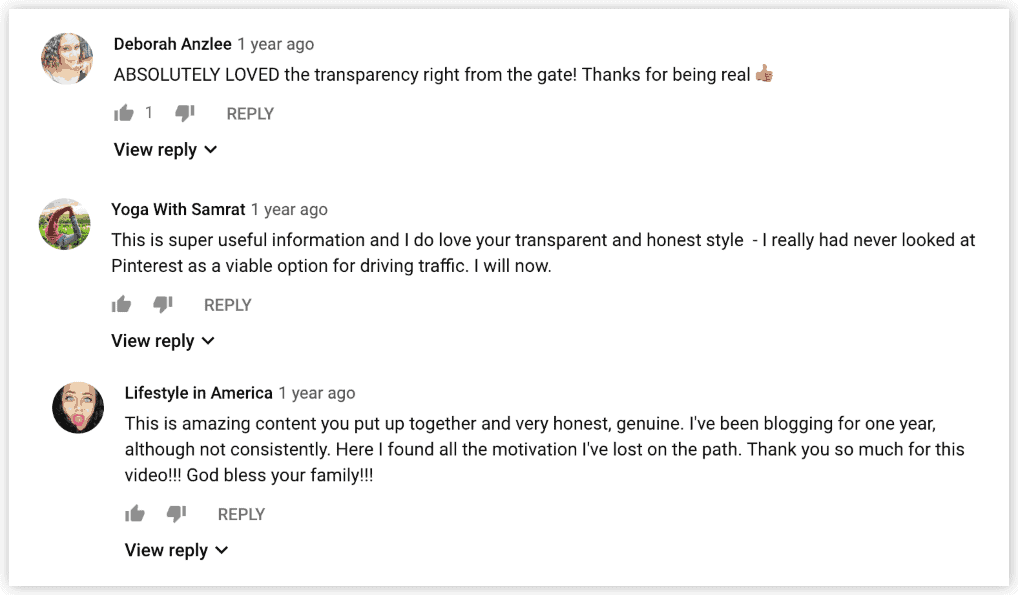
We never purposely tried to be transparent in any way. We were just honest about our struggles along the way. We don’t make it sound like sunshine and rainbows, because it wasn’t.
Just be honest about how you feel. Try not to be too polarizing but don’t be afraid to be opinionated and express those personal opinions.
This is how you create a targeted and loyal audience of fans and supporters.
7. Keep Your Design Simple and Professional
This is one of the blogging tips aimed more at beginners but it still applies even if you’ve been around the block for a few years. It’s one that’s easy to lose sight of.
I once spent DAYS trying to perfect our logo and header image on our blog, neither of which we kept on our blog for more than a week or so anyway.
The truth is that your blog design doesn’t matter a whole lot. You’re going to want it to look super fancy, but really, it should be a reflection of YOU.
This is what my health and wellness blog originally looked like:

Pretty bad, right?
But that was the design that my blog had when it earned over $40,000 one month when an article went viral and resulted in a lot of sales of a weight loss program.
This is what it looked like after we paid a web designer $1,000 for a custom design:

And guess what? Our sales didn’t change one bit after the redesign.
We upgraded to the Genesis Framework theme for our blog because we wanted to increase our page speed, but it’s not a very beginner-friendly theme when it comes to blog design.
So, we hired a web designer for $1,000 to redesign our website. Thankfully, the revenues at the time more than covered this cost.
Your blog design should, above all, be simple and professional.
Some website themes are more customizable (and affordable) than others. Divi is what we recommend for most beginners due to its very high level of customization.
You also get access to the 70+ other themes in the Elegant Themes package when you get Divi.
Genesis is more popular with more experienced bloggers but it’s a lot tougher to customize, especially without the purchase of additional plugins. It’s not ideal to start out with.
Get a good theme, keep your message simple and focused, and move on to the only thing that really matters: writing great content.
8. Traffic > Monetization (At First)
This is an important blogging tip because most people are SO overly focused on monetization straight from the get-go.
And if you have some steady and consistent traffic coming to your blog, you absolutely should be. Otherwise, you can forget about making money completely – for now.
Blog traffic can translate into…
- Email subscribers (which can translate into customers later on down the road)
- Helpful feedback (remember the ASK method we talked about earlier)
- Test dummies for optimization (learn what opt-ins are converting best and what content people are most interested in)
- Money (if you have properly monetized your website)
Compare that to monetization… A good method of monetization can translate into one thing and one thing only: MONEY.
But without traffic, you can’t make any money anyway.
So, think of all the benefits you get from focusing on traffic compared to focusing on monetization. This ties into ALL of the other blogging tips we have discussed so far, including:
- The importance of building an email list
- Learning who your target audience is and what they need help with
- Our first blogging failure because we created a product no one wanted
- Prioritizing the ONE most important thing that will help your blog grow (traffic > monetization FIRST)
- Taking the right steps at the right time (blogging from A to Z)
Focus on getting a solid source of steady and consistent traffic FIRST, and then work on monetizing that traffic.
9. Master a Source of Traffic
Speaking of blog traffic, let’s talk more about it.
We tried to get Google SEO traffic when we first started our first health blog, but we quickly realized that this was going to take a LONG time in such a competitive niche.
Then we heard about using Pinterest to drive blog traffic in an online forum and decided to give it a try. Well, more than a try.
I took a very deep dive into Pinterest. I bought courses. I poured over blog articles and analytics for hours to try to understand where growth was coming from so I could scale it.
After growing Pinterest accounts to over tens of thousands and even over 200,000 followers, this became a main source of traffic for a few years. We now sell a Pinterest course on these strategies.
The real secret behind this growth was just focused work.
Instead of jumping on every social media and search platform on the internet, we chose ONE source of traffic and put ALL of our efforts into mastering it.
If you try to do everything at once, you’ll end up mediocre at most and great at absolutely nothing.
It was only after really mastering Pinterest that we turned our sights back to Google SEO and learned everything we could about it.
Choose YOUR best source of traffic.
How do you decide what source of traffic will work best for you? Well, there are a few different questions you can ask yourself to help figure out where to start.
1. Where is your target audience hanging out?
Consider the demographics of your target audience.
If you’re targeting middle-aged women, YouTube and Instagram probably aren’t going to be your best bets. If you’re targeting young men, Pinterest will have far fewer of them than YouTube.
2. Where does your skill set lie?
Are you really great at getting on camera and recording videos? Are you an entertainer? If so, YouTube is your jam.
If you have a recipe blog and you’re good at taking professional photos, Instagram or Pinterest is going to be a better platform for you.
Here’s an example of how one of our blogging students, Bola, is killing it on her Instagram Account:
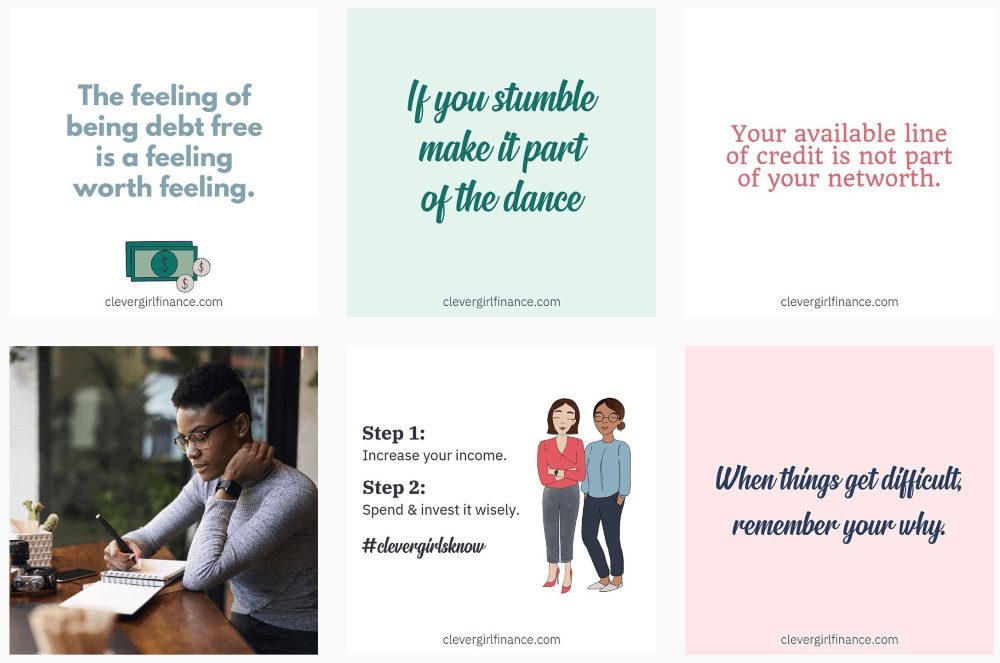
She uses a combination of motivational posts, videos, and other photos to connect with her audience.
3. What best suits your blog and content?
Think about how you plan to advertise your content.
If you’re a food blogger or travel blogger, your pictures will matter VERY much and you, therefore, want to select a very visual-based platform like Pinterest or Instagram.
If you have a lifestyle blog and you want to be an influencer, Instagram is probably going to work best for you.
4. What do you already know?
This might not be as important, but if you’re already super familiar with a platform and how it works, it might be a good one to begin with.
If you already have social media account that you’ve been growing personally, you can consider turning it into a business-branded account.
5. Consider the behavior of the platform.
This is THE most important question to ask yourself when you are deciding which platform to go with.
People interact differently with content on every platform, so you need to think about what you want your reader to DO when they see your content.
For example…
If your goal is to get a reader to click on a post, Instagram and YouTube might not be ideal for you because it’s VERY difficult to get people off of those platforms.
When a video is ending on YouTube, most people have a call-to-action on their end screen that is meant to keep the user on the platform like this one from our video end screen below:
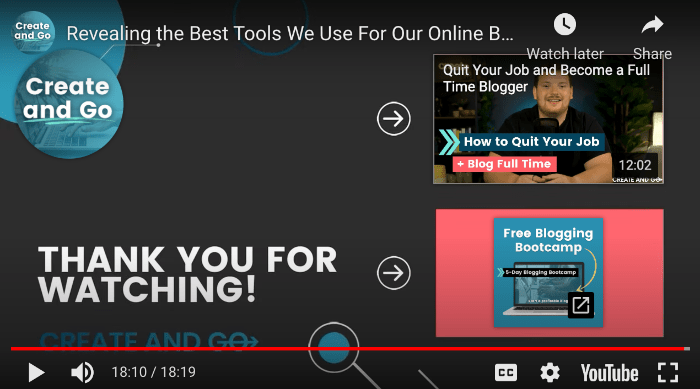
You can have a link to your website or email landing page, but you also have to include a link to another video so that they can stay on YouTube and keep watching.
People on Instagram or TikTok want to keep scrolling and people on YouTube want to keep watching videos.
But the upside of these platforms is that they are great for building trust and relationships with customers because they are more personal than other platforms.
Search engines like Google and Pinterest are GREAT for driving traffic to posts because the whole point of the search is that people are LOOKING for your content.
Why We Recommend Google SEO and/or Pinterest
We believe in building a good foundation on searchable traffic rather than pretty photos and popularity contests like you’ll find on Instagram or TikTok.
Pinterest is the better place to start for quicker traffic because it’s far less competitive than Google. It’s a good way for bloggers to get their first bit of traffic to start getting subscribers, testing out ideas and products, etc.
But Google SEO is still really important and you need to make sure that you have the basics covered, even from the very beginning.
10. Use the Right Blogging Tools
The blogging tools that you use won’t generally determine whether or not you find success, but they can certainly get you there faster!
There are SO many awesome tools out there to help with SEO, site speed, web design, and so much more.
Here are some of our favorite free tools. Some of these do have an option for a paid version, but the free version will generally give you everything you need!
Rank Math
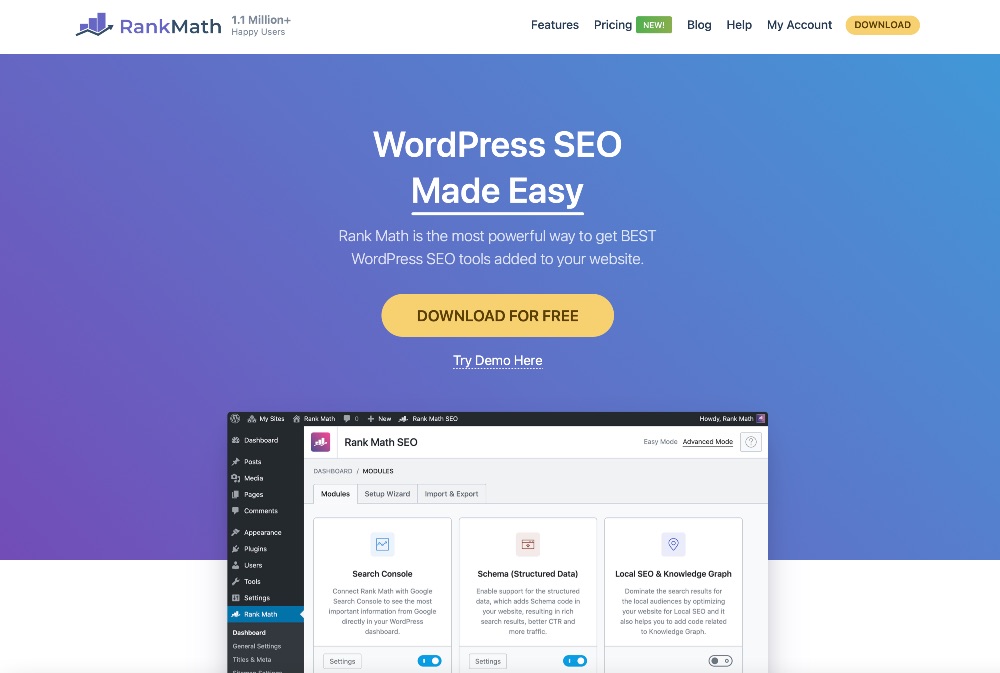
RankMath is one of our favorite and most recommended SEO tools.
SEO stands for search engine optimization, and it basically means optimizing your content to increase your chances of being found in Google search.
Google SEO can be very difficult and competitive depending on your blog niche.
But even if you aren’t actively trying to get Google traffic, this free plugin will help you optimize your posts so that they have a better chance of being found when people are typing in keywords related to your content.
It’s a great blogging tool that helps you to get more Google traffic organically and passively without having to do much extra work.
Rank Math uses a number- and color-based system to help you see how well your post is optimized for Google. When you have a low score, it color codes it red or orange, and it will tell you what you need to work on to get the green light and higher score on your posts.
You can download Rank Math plugin for free here.
Image Optimizers
When we started, I used to use a lot of stock photography and download the largest image with the highest quality so that it looked the best on our blog.
What I didn’t know was…
This was a MASSIVE drag on page speed and I was actually doing the opposite of what the best practice for website images was.
These big, beautiful images that I was uploading had large file sizes and took up a lot of space on our blog. This caused our posts and pages to load a lot slower and would ultimately lead people to leave our blog rather than wait for the content to load.
The images that you upload to your website should generally be the smallest file size possible without losing too much quality.
To minimize the file size, you generally need to first resize the image and then compress the image before uploading it to WordPress.
These are the tools that we use for image optimization:
- BeFunky – Free tool for resizing and other image edits
- Tiny PNG and Optimizilla – Free web-based image compressors
- Resize Image After Upload – Free plugin that automatically resizes photos to the right size in your content to improve page speed
Canva (Image Design)
While we’re on the subject of images, Canva is the best tool around for creating custom images and graphics.
This tool is what we use to create all of our Pinterest pins, YouTube thumbnails, sales page images, eBook covers, and other graphics.

If Adobe Photoshop intimidates you, you’ll LOVE this free software! It’s super intuitive and easy to use. There are also thousands of templates that you can choose from to start with!
It also saves your designs, so you can go back and edit them again in the future!
Page Speed
Remember how I said earlier that I had no idea how much I was tanking our website speed with the large, high-quality images?
It was only through page speed tools that I learned about this massive mistake.
If you haven’t ever checked your page speed, you need to open up a new window and do it RIGHT NOW.
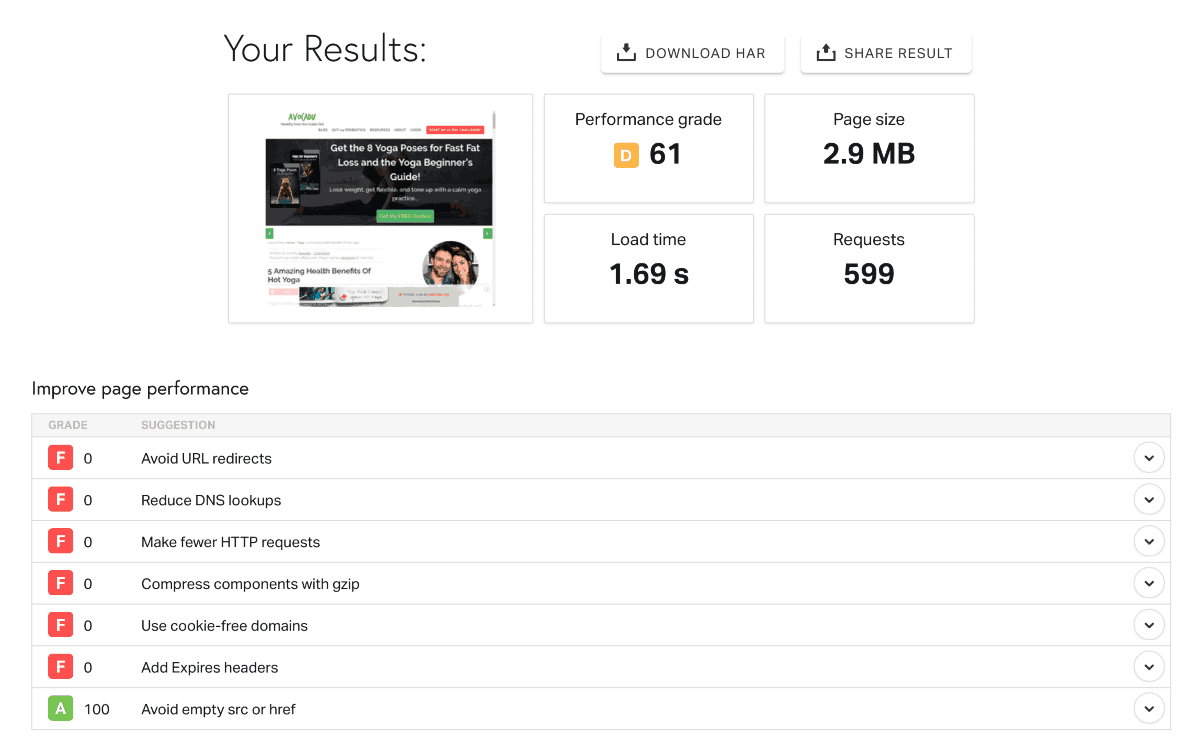
Your page speed matters more than anything else because if your website takes too long to load, your reader is gone before they’ve read the first word.
It also negatively impacts your website’s ranking for Google SEO.
Yikes!
TONS of different elements can impact page speed, including plugins, too many images that aren’t properly optimized, certain blog themes, redirects, caching, and more.
Recommended tools for page speed:
Give all three of these a try and see which one you like best! Try to get your page speed below 1.5 seconds of loading time.
Here are some additional plugins that can help increase page speed:
Additional Free Blogging Tools:
- Readability Checker – It analyzes the content on your page and lets you know how to improve the readability of your content.
- Pixabay (Stock Photography) – You can’t use photos you find in Google search safely and without fear of copyright infringement because you don’t own them. Stock photography provides professional-looking photos for your website that are legally free for all to use.
- Google Analytics – Make sure you’re tracking your blog traffic with Google Analytics because it’s more accurate than tools like JetPack. It also provides all kinds of other stats and demographics on where your traffic is coming from.
You can also view our complete guide on the best blogging tools here.
11. Embrace Failure and Learn From It
Fear sucks. It often keeps us rooted in place and not growing as quickly as we’d like. Whether that is personally or professionally.
But we need to stop fearing fear so much. Fear is what keeps you alive and you can’t eliminate it.
Fear of losing your apartment keeps you paying the bills and the fear of getting fat keeps me from eating oreos for breakfast.
The goal should not be to eradicate fear or become “fearless” but rather learn to become aware of fear, acknowledge that it exists, understand why it’s there, and then push through it anyway.
Learn how to deal and act anyway. In a way, it’s just another form of confidence.
How to Turn Fear Into Confidence
We started out with a lot of fear. We quit our jobs before we were making any money to try to “make money from a blog.” It was scary as hell.
But we did our best to turn our fear into confidence by framing all of our mistakes as learning opportunities.
Because with every failure, we learned more about why we failed and how to be better. We tried something new.
We were able to transform our first failed product into a highly successful weight loss program that we sold for years:
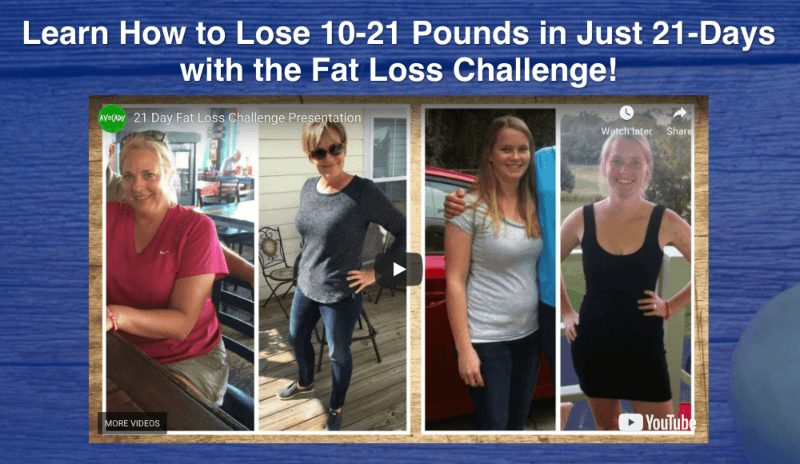
The next time around, we made sure to make entirely new mistakes and learn from those as well.
These mistakes and learning opportunities became the arsenal of knowledge that we now teach in our courses on blogging. No regrets.
This ties back into what I discussed earlier about drawing confidence from your experiences and feeling comfortable in your own skin.
Try writing blog posts and content from your experiences and you’ll naturally feel a lot more confident.
12. Make Sure Your Blog is Mobile-Friendly
Did you know that anywhere from 50-80% of all visitors on your website are accessing it from their mobile devices?
That percentage tends to fluctuate depending on the demographics of your audience, but it’s still a HUGE percentage of all web traffic.
Here is a screenshot of our traffic by device for our health and wellness blog:

You can find this information in Google Analytics.
As bloggers, we tend to get overly focused on how our website looks on a desktop or laptop because that’s primarily how we write, design, and view our own content.
I know I personally ALWAYS used to forget to check my posts on mobile after I set them up. I often wouldn’t know of problems with my site on mobile until a reader told me. At that point, it had often been messed up for weeks.
Yikes.
There are a couple of different factors to consider here.
Mobile Page Speed
The first one is page speed. Now, we won’t get into the details here because we discussed it in the tip on blogging tools earlier.
People tend to have even less patience waiting for a page to load on their mobile devices than they do on a desktop.
If your page speed on mobile is lacking, people are going to bounce to another article on another blog.
Make sure to implement the earlier steps on page speed and to use the page speed tools to check mobile page speed as well as desktop speed.
Mobile-Responsiveness
Make sure you’re using a mobile-responsive theme, which just means that your theme was designed to display your content on multiple screen sizes.
The coding in your website’s theme will automatically resize and display your headlines, images, margins, and content according to the screen size they are viewed on.
Most good blog themes are mobile-responsive these days.
BUT you need to always check new content on mobile after you add it to make sure everything is spaced correctly and displaying properly.
Here are a few tips:
- Distraction-free and simple menu
- Make sure your headlines stand out against the body text.
- Your margins shouldn’t be too wide or too narrow.
- Make sure your have good content size and spacing between elements.
You’ll often find that certain images, headlines, or other content don’t quite show up how you want them to on mobile and you’ll need to play around with it a bit to get it to display correctly on mobile.
Remember that with THAT many users viewing your content from a mobile device, the display of your website on mobile is generally going to be even MORE important than desktop.
13. Successful Blogger = Successful Marketer
Do you know what running ANY type of online business is really about?
Marketing.
Without a good marketing strategy, you won’t get people reading your content, signing up for your email list, or purchasing any products from you.
So many people believe that blogging is just about writing good content, linking relevant products, and waiting for the money to just roll in.
This couldn’t be further from the truth.
It’s about good marketing.
But the thing is…
Marketing doesn’t have be super hard or super salesy. It’s really just about communicating the right message to the right people.
Something that we missed with the first failed blog, as I mentioned before. That first product that we created didn’t fail because it sucked.
It failed because our marketing message was off, which was because we didn’t know our target market yet.
After learning who that was, we started off our sales page with a banner speaking specifically to that target market:

Most bloggers simply don’t understand the importance of marketing and therefore never realize their full potential because of it.
Many of them are so overly focused on their product and sales that they completely forget about the importance of the message.
If Person A has a mediocre product but a strong marketing message and Person B has an incredible product but a poor marketing message, guess who is going to be more successful?
Person A, 97% of the time.
Despite having a lesser product, they will sell far more products because their marketing game is stronger.
Affiliates will also gravitate towards the product that sells better over the one that performs better because they are driven by sales numbers.
How to Up Your Marketing Game
Let’s talk about how you can shift your focus from a sales perspective to a marketing perspective.
Approach EVERYTHING you do from the standpoint of marketing, and you will quickly begin to rise above your competition.
Here are a few examples of what we mean by EVERYTHING:
- Blog Titles – Your headlines matter. Problem-solving, keyword-optimized titles > cutesy, clever titles.
- Blog Content – Write content that solves your readers’ problems in a way that also educates them about the need for the products that you are selling.
- Email Opt-Ins – If your freebies aren’t converting enough readers into subscribers, your freebie offer or product is missing the mark. Try a new one.
- Product Names – Same applies as above. Cutesy titles < Problem-solving, keyword-optimized titles.
- Sales Pages – Remember who your target customer is and speak to that ONE person throughout your entire sales page.
- Traffic – Use images and headlines that directly speak to your target customer and people will naturally be more drawn to your content.
- Customer Service – Provide the absolute best support possible for your products and people will naturally provide higher ratings, better testimonials, and share their results with others.
These are just a few of the ways you can begin improving your marketing strategy throughout your blog.
Bottom line: If you want to be a successful blogger, you must be a successful marketer.
14. Sell High-Priced Products
Here’s a quick example to illustrate this concept:
Let’s say my goal is to earn $10,000/month with my blog, which was my first very real monetary goal when I first started.
- If I’m selling an eBook for $47, I would need to sell 212 products in a month to hit my goal.
- If I was selling an online course priced at $297, I would only need to sell 34 products in a month to hit my goal.
Depending on how much traffic you are getting to your blog and what niche you are in, that difference of 178 products can be HUGE.
Some niches and topics naturally get a lot more search volume than others (i.e. “weight loss” compared to “blogging”).
So, depending on your blog niche, massively increasing your blog traffic might not be an option if there is far less search volume for your topic.
But here’s the other thing. It’s also much harder to sell high-priced products.
The higher the price of the product, the more you will need to pre-sell and build trust with the customer before they land on your sales page.
How to Sell High-Priced Products [Well]
This process can be used both for affiliate marketing and for selling your own products.
The focus here is on pre-selling the customer.
This means that you need to provide valuable content upfront that both needs to build trust with your target customer as well as educate them on why they need your product.
There are two main steps you need to take in order to accomplish this.
1. Create sales-centered content.
The first step is to create sales-centered content designed to bring in your target customers.
Unless you are monetizing with ads, you don’t want traffic just to have traffic. You want targeted traffic that is interested in what you have to sell.
To get the right kind of readers, you need to create content centered around the topic(s) that your product(s) are about.
For example, if I’m selling a weight loss program for women, I would create content focused on…
- the different ways to lose weight,
- some problems my target customers might be facing,
- and some solutions to solve those problems.
Here is an example of a few posts designed specifically around common weight loss struggles that my customers were facing:

At the end of all of these articles is a call-to-action to purchase our weight loss program!
2. Get their email address.
I discussed the importance of turning your audience into subscribers in one of my earlier blogging tips, but I will take it a step further now.
If you’re selling a product at this point, the goal is NOT to get as many email addresses as possible. It’s to get as many targeted email addresses as possible.
I first learned this when I had a very successful opt-in on recipes. The conversions were high and people loved it.
The problem was that I had no product to sell related to healthy recipes. Those people weren’t as interested in my weight loss product, so they just sat on my email list with no real purpose.
I was targeting the wrong group of people.
I found that a freebie of weight loss tips converted fewer people but those that did convert were far more targeted towards my weight loss product.
Compare that to this opt-in designed by one of our Six-Figure Course Creator students, Natalie Bacon:

Her free course was designed to sell her full, paid program, which was about the exact same topics: mindset, productivity, time management, goal-setting, and habits, which is what her full course is about.
Create a lead magnet (freebie) that attracts your target customer and is directly in line with the product you are selling.
3. Create a sales funnel to sell the product.
Once you have their email address, you need to start sending them emails to start building that relationship with your potential customer.
An effective sales funnel provides a significant amount of value upfront before eventually introducing the product and asking for the sale.
First, send your target customers at least 2-3 emails of free content relating to the product you are selling.

This content can be similar to the sales-centered content you created in step 1, but try to be more personal in your emails. Tell your story whenever you can.
It’s okay to link your product at the bottom of your emails, but don’t try to sell too hard too soon.
If you don’t provide enough value upfront before asking for the sale, your customer will get turned off and feel that you’re only trying to sell them something.
After you’ve provided that value upfront, it’s okay to introduce your product with a strong push to purchase.
Remember that this is a big trial and error phase as well.
If your emails aren’t selling your product, write new emails, create new opt-ins, and continue to test out different ideas until you get it right!
15. Create a Better ‘About Me’ Page
This is probably one of the blogging tips that you wouldn’t expect and our About Us has changed a lot over the years.
But we’ve stuck with it since making it a bit more personal. It’s not just about how and why Create and Go was started.
It’s about the entire journey. Because that part is relevant to our audience too.
I initially didn’t think anyone would ever want to read that much info about the journey, but apparently I was wrong.
As soon as we added the extra content and tons of photos to that page, the comments started pouring in. So many people told us that they read EVERY word, and I was totally blown away.

Our story was giving our readers the inspiration and motivation that they needed to get off the fence and make the next move in their blogging careers.
We now have over 50 comments just on that page. It’s crazy!
People WANT to hear your story, and this is one of the easiest ways to give your readers an opportunity to get to know you better.
DO THIS NOW:
Create a timeline of events that tie your story into why and how you started your website. Include tons of photos and honest thoughts and feelings.
Check out our About Us page for reference.
Your audience will love it!
16. Follow the 80/20 Rule
Another big mistake that we made at the beginning with our first blog is that we assumed that we knew what our audience wanted us to write about based on what WE wanted to write about.
We ended up with a bunch of well-intentioned but completely useless content.

You can see that we used a lot of words like “shit,” “bangin’,” and “badass” because we thought our audience was full of fellow 25-year-old singles looking to stay in shape.
It looked cool, but that’s about it.
We were totally guessing at everything and creating content that we thought other people would be interested in.
As we got better at blogging (aka tried and failed at many more things), we began to get the hang of things and found that there was a specific ratio of content that seemed to work out really well for us.
Create content people are searching for: the 80%.
The best type of content you can create is based on the topics and keywords that your audience is actively searching for.
There is very little guesswork or assumptions here and they are searching because they actually want or need something.
It’s a win-win situation.
So, how do you find what topics and keywords your audience is searching for?
Keyword Research
You can use keyword research tools to see what keywords people are searching for and how much search volume-specific keywords have.
Some of the best keyword research tools like Ahrefs and SEMrush are also pretty pricey.

If you can afford it or if you are actively working on your Google SEO game, these are the best tools on the market and are definitely worth the cost.
The two most important SEO tools that we choose to invest in are Ahrefs and SurferSEO.
If you can’t afford one of these tools, that’s okay too. There are a couple of free options that you can use as well.
The first one is a keyword research tool called Ubersuggest by Neil Patel.
To use this tool, simply type in a suggested keyword into the search bar. We used “Yoga Poses” for this example. You can then see some data on search volume, keyword difficulty, and more.
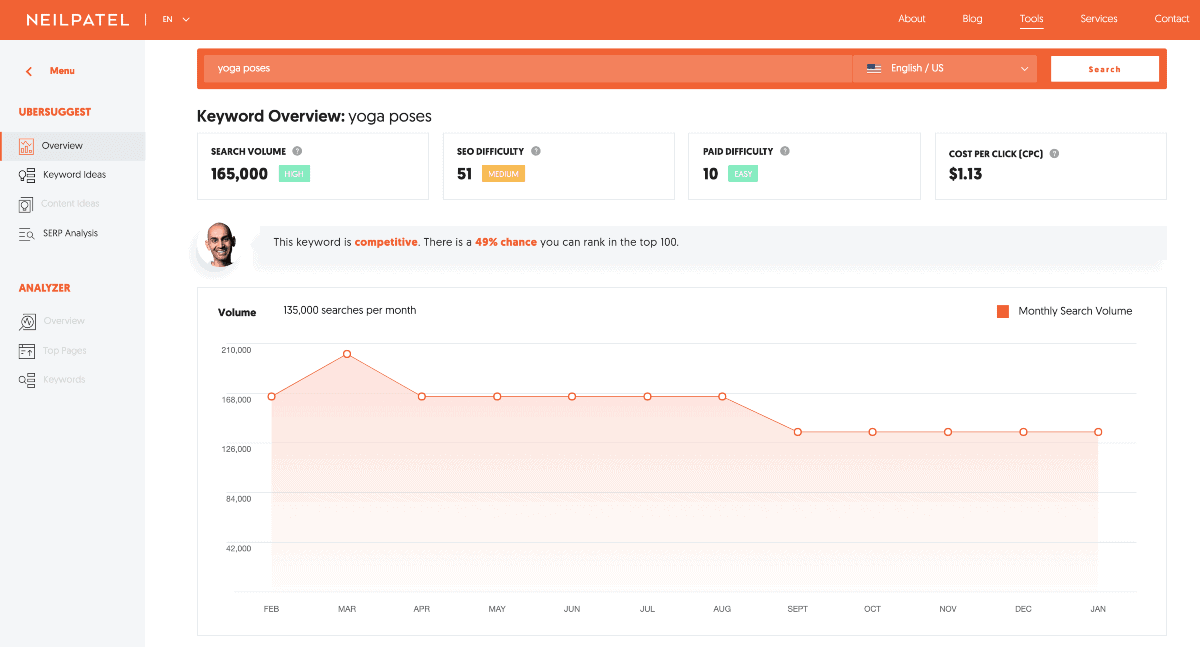
If you scroll down, you can also see related keywords and other information on who and what is currently ranking for the selected keyword.

It’s a great free tool to use to get started, but keep in mind that you only have 3 free searches per day on the free version.
You can read more about our favorite keyword research tools here.
Another method is through Pinterest search.
This is a great resource if you are using Pinterest as a major source of traffic for your blog.
To use Pinterest search to find keywords, simply type in your keyword in the search bar. We’ll illustrate how to do this with the same keyword, “Yoga Poses.”
If you type in the term “Yoga Poses” into Pinterest search, a number of additional suggested keywords will appear under the search bar.

In this example, you can see that some of the other suggested keywords include “yoga poses for beginners, yoga poses for flexibility, yoga poses for abs, etc.”
This is a great way to find popular keywords in your niche on Pinterest.
This keyword-based searchable content should make up approximately 80% of the content on your blog.
Experiment with new topics, ideas, and trends – the 20%.
This is the part where you get to have a little more fun with your content and really express your creativity.
You can dedicate 20% of your content to the following:
- Trending topics in your industry
- Personal testimonials and experiences your customers may have with your products
- Your personal experiences, tips, and lessons
- Anything else you think your audience might be interested in or need!
One good example of an article of ours like this is our article on the phases of blogging success.
This article has virtually no chance of ranking for any keywords in Google search and it has the word POOP in the title…
But we wrote this article specifically with our audience in mind. We knew that many of our bloggers were struggling with fears, doubts, concerns, and overwhelm and we wanted to write something that would inspire them.
So, we wrote an honest article on our success journey.
It’s divided the ups and downs we experienced and overcame into four different phases that we have found most others experience as well.
It was written for our bloggers stuck in the trenches, not making any money yet, and feeling like they were never going to make it out the other side alive.
We wanted to show them that there IS a light at the end of the tunnel and help them know what to expect in the coming months and years.
The article received an overwhelmingly positive response and TONS of comments:
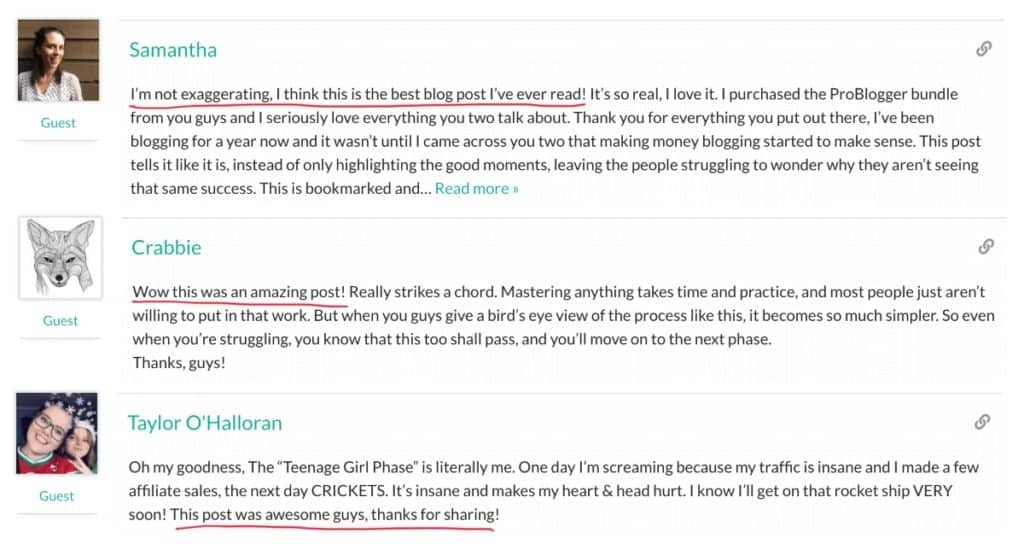
Brainstorm some creative content that you think would be the most useful to your audience, even if it’s goofy, personal, or has zero chance of ranking in Google!
Your audience will LOVE you for it!
17. Get a Move on!
If this is your fifth time reading an article searching for blogging for beginners, it’s time to read less and do more.
We tried to provide as many actionable blogging tips in this article as possible because you will only find success by actually taking action.
Most of the blogging tips in this article came straight from lessons that we learned from the actions that we took along the way.
Remember that it’s about trying new things, embracing failure when it happens, and turning all failures and mistakes into learning opportunities.
Please go back through this article and make sure you implement as many of these tips and strategies as possible if you haven’t yet!
You can also start by leaving a comment under this article to tell us what action(s) you are going to take TODAY to implement these blogging tips and keep yourself accountable!
We’d love to hear from you!
